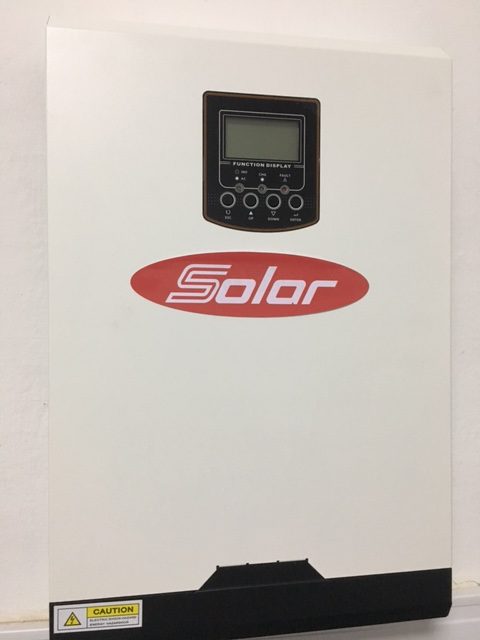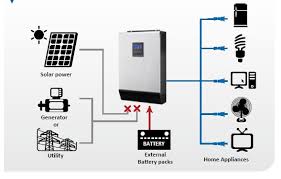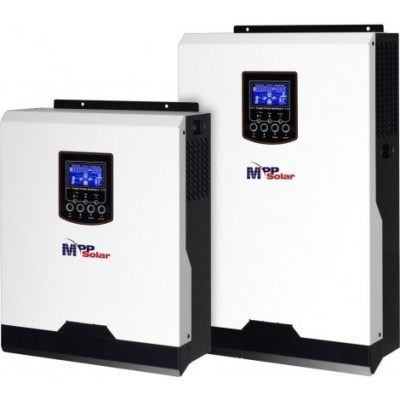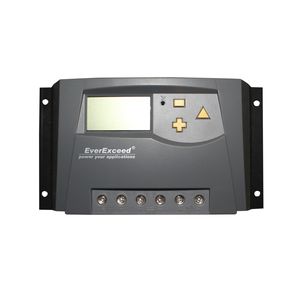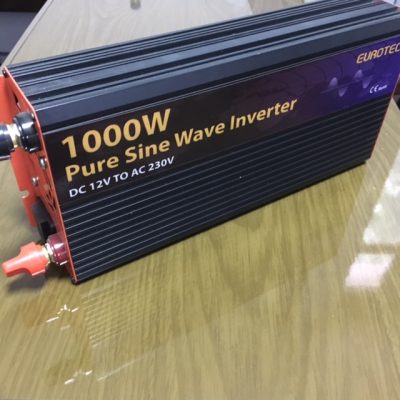Descripción
En Español
El MPPT también incluye un inversor de corriente para convertir la tensión de las baterías (generalmente de 12 voltios o 24 voltios) a los 230 voltios que consumen los equipos de nuestra instalación. Además, el inversor también se encarga de transformar la señal de corriente continua a corriente alterna, cuya forma de onda es sinusoidal pura para poder alimentar a todo tipo de electrodomésticos o equipos electrónicos.
Por último, los también incluyen un cargador mediante el cual poder conectar un generador auxiliar. El cargador se puede utilizar para cargar las baterías cuando ésta se encuentra en valores de tensión bajos, cuando se quiera dar suministro directo a las cargas de la vivienda en momentos que se prevea un consumo más importante, o, mediante el bypass, dar carga a ambos circuitos, la batería y la vivienda a la vez. Todos estos parámetros son modificables en las opciones de programación que incluye el y que están resumidas más abajo (también se pueden ver en el manual del equipo).
Hay que tener en cuenta que si el diseño de la instalación fotovoltaica está bien hecha, adquirir un grupo electrógeno junto a la instalación fotovoltaica no es estrictamente necesario, ya que entre la producción solar y la autonomía en baterías sería suficiente para cubrir el 99% de las situaciones de diseño. Un buen grupo electrógeno compatible con nuestra instalación puede resultar caro si se le va a hacer un uso de un par de días al año a lo sumo. Independientemente de la solución escogida al respecto, el hecho de que la instalación fotovoltaica tenga un cargador para poner conectar el grupo electrógeno si que puede resultar clave para tener al menos la solución disponible para cuando se requiera.
- Todos los inversores/cargadores vienen programados con unos valores por defecto para un tipo de baterías. Valores de tensión baja de batería, tensión de absorción y flotación, etc. Si las baterías que vamos a utilizar son GEL o AGM lo más seguro es que debamos cambiar estos parámetros.
- Cuando conectamos un grupo electrógeno a un inversor/cargador, además de la potencia necesaria para alimentar el cargador, el grupo debe ser capaz de suministrar energía a los consumos de la vivienda. En el ejemplo anterior, si en la vivienda está el microondas funcionado y tiene una potencia de 700W, el generador deberá ser capaz de proporcionar los 720W + 1440W = 2160W (como referencia podemos contar unos 2500VA, dependiendo del factor de potencia del grupo). En caso de que el grupo fuese de solamente 1500VA sería necesario programar el inversor/cargador para limitar la corriente de demanda del grupo.
- Los inversores/cargadores incorporan uno o varios relés programables para por ejemplo, el arranque automático del grupo electrógeno. Si queremos modificar los valores de tensión de batería que accionan el relé, el horario de funcionamiento restringido del relé u otra aplicación, necesitaremos programar el inversor.
- Las cargas de ecualización están desactivadas normalmente por cuestiones de seguridad, para activarlas es necesaria la programación.
In English
The MPPT also includes a power inverter to convert the voltage of the batteries (usually 12 volts or 24 volts) to the 230 volts consumed by our installation equipment. In addition, the inverter is also responsible for transforming the signal from direct current to alternating current, whose waveform is pure sinusoidal to be able to feed all types of appliances or electronic equipment.
Finally, they also include a charger through which to connect an auxiliary generator. The charger can be used to charge the batteries when it is in low voltage values, when you want to give direct supply to the loads of the house at a time when a more important consumption is foreseen, or, by means of the bypass, give charge to both circuits, the battery and the housing at the same time. All these parameters are modifiable in the programming options included in it and are summarized below (can also be seen in the manual of the equipment).
It must be borne in mind that if the design of the photovoltaic installation is well done, acquiring a generator set next to the photovoltaic installation is not strictly necessary, since between solar production and autonomy in batteries would be enough to cover 99% of the design situations. A good generator set compatible with our installation can be expensive if you are going to use it a couple of days a year at the most. Regardless of the solution chosen in this regard, the fact that the photovoltaic installation has a charger to connect the generator set can be key to having at least the solution available when required.
- All inverters / chargers are programmed with default values for a battery type. Values of low battery voltage, absorption and floating voltage, etc. If the batteries that we are going to use are GEL or AGM, the safest thing is that we should change these parameters.
- When we connect a generator set to an inverter / charger, in addition to the power needed to power the charger, the group must be able to supply energy to the consumption of the home. In the previous example, if the house is in the microwave and has a power of 700W, the generator should be able to provide the 720W + 1440W = 2160W (as a reference we can count about 2500VA, depending on the power factor of the group). In case the group was only 1500VA it would be necessary to program the inverter / charger to limit the demand current of the group.
- The inverters / chargers incorporate one or more programmable relays for, for example, the automatic starting of the generating set. If we want to modify the battery voltage values that trigger the relay, the restricted operating time of the relay or another application, we will need to program the inverter.
- The equalization charges are normally disabled for security reasons, to activate them programming is necessary.

